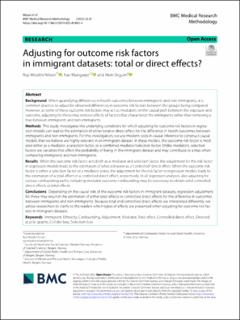| dc.description.abstract | Background
When quantifying differences in health outcomes between immigrants and non-immigrants, it is common practice to adjust for observed differences in outcome risk factors between the groups being compared. However, as some of these outcome risk factors may act as mediators on the causal path between the exposure and outcome, adjusting for these may remove effects of factors that characterize the immigrants rather than removing a bias between immigrants and non-immigrants.
Methods
This study investigates the underlying conditions for which adjusting for outcome risk factors in regression models can lead to the estimation of either total or direct effect for the difference in health outcomes between immigrants and non-immigrants. For this investigation, we use modern tools in causal inference to construct causal models that we believe are highly relevant in an immigrant dataset. In these models, the outcome risk factor is modeled either as a mediator, a selection factor, or a combined mediator/selection factor. Unlike mediators, selection factors are variables that affect the probability of being in the immigrant dataset and may contribute to a bias when comparing immigrants and non-immigrants.
Results
When the outcome risk factor acts both as a mediator and selection factor, the adjustment for the risk factor in regression models leads to the estimation of what is known as a “controlled” direct effect. When the outcome risk factor is either a selection factor or a mediator alone, the adjustment for the risk factor in regression models leads to the estimation of a total effect or a controlled direct effect, respectively. In all regression analyses, also adjusting for various confounding paths, including mediator-outcome confounding, may be necessary to obtain valid controlled direct effects or total effects.
Conclusions
Depending on the causal role of the outcome risk factors in immigrant datasets, regression adjustment for these may result in the estimation of either total effects or controlled direct effects for the difference in outcomes between immigrants and non-immigrants. Because total and controlled direct effects are interpreted differently, we advise researchers to clarify to the readers which types of effects are presented when adjusting for outcome risk factors in immigrant datasets. | en_US |

